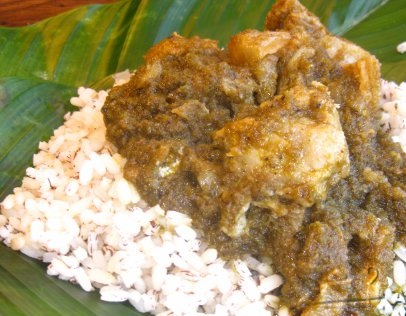
Ofada Rice and stew is a Nigerian meal native to the Yorubas but in recent times, everyone, especially those in Lagos and environs, has been bitten by the Ofada Rice bug.
Ofada Rice is not very interesting. It is not as posh as the long grain parboiled rice. The “best” part? It has this strong pungent smell when it is being cooked yet everyone wants to eat it! I guess it is because Nigerians have a penchant for all things traditional and home grown. We have a sense of pride in all things Nigerian that we can call our own.
Or maybe it’s the stew because I must say the Ofada Stew adds a delicious twist to Ofada Rice.
Ingredients for Ofada Stew
•40 pcs unripe habanero peppers
•2 green tatashe peppers or green bell peppers
•1 locust bean seasoning (Iru, ogiri okpei or dawadawa)
•20cl red palm oil (at least)
•1 big onion
•1 handful crayfish
•850g assorted meat and fish. I used: ◦Beef
•Shaki (cow tripe)
•Dry fish
•Stock fish
Before you cook Ofada Stew
1.
Wash and blend the peppers and the onion. Remember to remove the seeds from the green tatashe or the green bell peppers.
2.
Grind the crayfish and the locust bean seasoning with a dry mill.
Cooking Directions
1.
Cook all the meat and fish with the stock cube till well done.
2.
Pour the pepper blend into a separate pot and cook on high heat till all the water dries up.
3.
Pour the red palm oil into a clean dry pot and bleach till it turns clear. It should look like vegetable oil when done. It took me 12 minutes on low to medium heat to bleach the one in the video below. Your own time may vary depending on the type of heater you have and the quantity of oil.
4.
Leave the oil to cool down a bit then add the boiled pepper puree. Fry till all the water has dried from the pepper.
5.
Add the crayfish and locust bean seasoning, the orisirisi meat and fish and stir well.
6.
Add salt to taste, leave to simmer and it is ready to be served.
Serve with Ofada Rice. To get the full effects, line the plate with uma leaves. You can also use banana leaves.
Tips for bleaching red palm oil
1.
Bleach the palm oil with a clean dry stainless steel pot. Aluminium pots work well too. Never use non-stick pots or enamel pots when bleaching red palm oil.
2.
If possible, use a free flowing pure red palm oil. The congealed almost yellow ones contain some water.
3.
Use low heat when bleaching the oil. This ensures that the oil is not very dark when done.
4.
Do so in a well ventilated area. Turn on your kitchen extractor to remove the smoke as much as possible. Turn off your smoke alarm if any, you don’t want everyone to know that you are cooking Ofada Stew. 😉
5.
Do not leave the pot unattended because the oil will catch fire if overheated. Check it constantly and turn off the heat once the bleaching is complete.
6.
Do allow the oil to cool down a bit before adding the ingredients. This will prevent hot splashes of oil and will keep your food from burning due to the high temperatures.
Click the link below to go to…
‘My Hubby Wasn’t Sacked From Air Nigeria, We Are Living Fine–Omotola Reply Critics
Peter Of P-Square, Lola Omotayo, Celebrate Birthday With Son, Cameron
Nollywood Most Passed Around Yoruba Actresses
Genevieve Nnaji Rocks New Low-Cut Look
Domestic Violence: Frank Edoho & Zaki Adzay Abused Ex-wives Speak Out (Video)
Ruggedman Speaks on controversial Rick Ross”Hold Me Back” Video



















